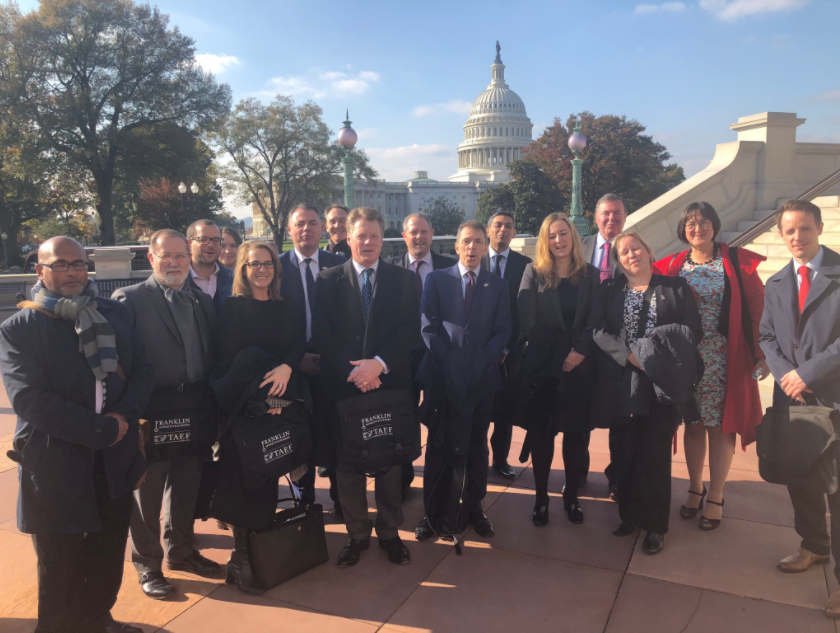Reaching for the moon: pioneering apprenticeships in the US
In November 2017, OneFile co-founder and director, Susanna Lawson, attended the Transatlantic Apprenticeship Exchange Forum in Washington, DC. Here are some insights from her trip.
Last week I attended my third Transatlantic Apprenticeship Exchange Forum to help pioneer apprenticeships across America. I was in Washington DC for three days of interesting panels and discussions.
In June 2017, President Trump signed an executive order to increase the number of US apprenticeships to 5 million by 2022. So far, the US government has invested $265 million in apprenticeships, with a further $90 million promised in 2017/18. The amount already invested by the government equates to $4,000 per apprentice. If the government scaled this over the 5 million apprentices they're aiming for, £20 billion will be required overall. The UK apprenticeship investment is between £1,500 and £27,000 per apprentice. In the UK, this is either funded by the employer, or co-funded by the employer and the UK government.
Following Trump's executive order, a Task Force on Apprenticeship Expansion was created, and we were lucky enough to observe one of their meetings. Secretary Acosta, Secretary DeVos and Ivanka Trump attended the session, where each member put forward their recommendations for creating apprenticeships that are both portable and stackable. Secretary Acosta expressed the urgent nature of the issue, stating 'for every week we delay, we’re affecting real people and real jobs,' and that apprenticeships are needed not only to create lifelong earners, but lifelong learners.
The hunger is there to reach the 5 million apprenticeships target set by President Trump and Salesforce's Mark Benioff, but it's still unclear exactly how they're going to reach it.
Apprenticeships already exist in the States, but there's no clear definition of what can be called an apprenticeship. Currently, there are thousands of registered apprenticeships which have been formally agreed and signed off at federal or state level. However, there are also thousands of non-registered apprenticeships which are essentially unregulated vocational training programmes labelled 'apprenticeships.'

This is the first problem America must overcome. Currently, only 0.3% of the US workforce is completing a registered apprenticeship – compared to 3% in the UK – but there is no visibility of how many are completing an unregistered apprenticeship. The US needs to increase the number and quality of official apprenticeships to tackle its skills shortage. There are currently over 6 million open job vacancies in the US, and 65% of these will require post high-school training by 2020. Like the UK, the US also wants to extend apprenticeships into higher education and include non-traditional subjects like cyber, finance and healthcare. Paul Ray, Counselor to the Secretary, US Department of Labor stated, 'both university and apprenticeships need to be promoted as plan A' and that parents, schools and employers need to stop being told degrees are the only way to success – a sentiment we echo here in Britain.
Bob Lerman from the Urban Institute in Washington DC has also been a huge advocate of apprenticeships to tackle the widening skills gap for years. He believes American apprenticeships should combine predefined standards with bespoke elements so the same qualifications can be used by different employers across different states.
The problem is that many employers don't know where to start. During discussions, everyone at the event agreed that apprenticeships should be employer-led, but there was a large debate about how broad or narrow the qualifications should be. Should everyone use the same standards, or should each employer have the right to create their own?
Daniel Kuehn – also from the Urban Institute – wants a happy medium. He's pioneering the 80/20 rule, and stated that apprenticeships with 80% standard qualification and 20% bespoke content are much more likely to get registered. This structure is more similar to that of UK apprenticeships.
If we're going to help the US follow our apprenticeship model, we need to start with employers. The UK Government's new apprenticeship model has put employers in the driving seat, which has encouraged large companies to engage with the process. And that's exactly what the US needs to do too.
South Carolina has already started this journey. Last year, only 90 employers hired apprentices, but this has expanded to over 900 employers employing over 22,000 apprentices. Brad Neese, Associate Vice President and Director of Apprenticeship Carolina, spoke about the reasons behind the state's success. They've brought in a new initiative where companies relocating to South Carolina must have an apprenticeship strategy.
This is a huge challenge for the US, but if more states follow South Carolina's lead, they can make it work. The Transatlantic Apprenticeship Exchange Forum has been supporting this change, allowing experts from around the globe to come together, share best practice and really make a difference for the future of America – and the rest of the world.
This article includes research and opinion sourced by OneFile at the time of publication. Things may have changed since then,
so this research is to be used at the reader's discretion. OneFile is not liable for any action taken based on this research.


